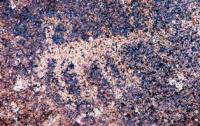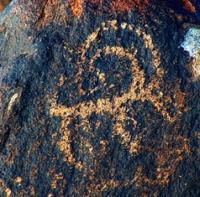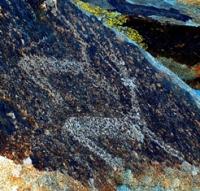Вы здесь
Petroglyphs of Fergana valley.



Petroglyphs excursions on Kyrgyzstan.
“Does progress mean that we dissolve our ancient myths? If we forget our legends, I fear that we shall close an important door to the imagination”
James Christensen.
Cave paintings and Petroglyphs Kyrgyzstan.
Fergana Valley (Kyrgyzstan). The Fergana Valley lies in the north-eastern part of Central Asia and represents an intermountain basin, bounded in the north and north-west by the Kuramin and Chatkal Ranges, in the east and north-east by the Fergana Range, in the south by the Alay and Turkestan Ranges.
It is connected to the Turan lowland by a narrow passage in the west of the valley, the so-called "Khujand Gates". The valley terrain has several distinctive features: the surrounding mountain ranges reach considerable altitudes of up to 5,000m above sea level in the south, up to 4,000m in the east, and up to 2,000 - 3,000m in the north and northwest.
The foothill area is formed by low-mountain ranges, adyrs, and intermontane valleys; the central part is a proluvial-alluvial plain watered by the largest river in the region, the Syrdarya, with its main tributaries, the Naryn and Kara Rivers.
The long valley is about 300km long for a maximum width of 140km (Geller et al. 1958: 521 - 527, 572 - 578; Sultanhodjaev 1972: 5 - 9). Fergana territory is administratively part of three Central Asian countries: Kyrgyzstan, Uzbekistan and Tajikistan. In its Kyrgyz part, there are three regions: Osh, Jalal-Abad and Batken, where 40% of the population resides.
The main occupation is agriculture in the foothills, combined with livestock farming. Ethnically, the population consists of Kyrgyz, Uzbeks, Tajiks, Russians, and others. Archeological Context in the Valley The area was first peopled in the Lower Paleolithic.
There are sites of later Stone Age periods (History 1998). During the Bronze Age (end of IIIrd – beginning of IInd millennium BC), the eastern and southeastern parts of the valley had a settled farming culture related to the Bactrian and Margian archeological complexes (Rogozhinskiy 2008: 83 - 924).
The Late Bronze Age is represented by two cultures: Kayrak-Kum from cattle-farming tribes (common in the western part of the valley) and Chust (in the north, in the east and the southeast), a group of cultures with painted ceramics common at the end of the IInd millennium BC in Bactria, Merv Oasis and Sogd (Complex Yaz I) (Zadneprovskiy 1997: 67 - 72).
A coexistence of cattle-farming and settled agricultural peoples is characteristic for the Early Iron Age in the history of Fergana as well (Baratov 2007: 20). The Antique Period in the history of Fergana is characterized by a rapid development of settled farming, and later of an urban culture.
Sites in Shorobat and Markhamat Complexes demonstrate this process. Pastoralists become less numerous and occupy peripheral areas of oases or concentrate in mountain valleys adjacent to Fergana (History 1984: 182 - 197).
The Early Middle Ages were marked by a series of significant socioeconomic and political events, ethnic and religious changes that had a radical impact on the further material and spiritual culture of the region (Central 1999).
In the Kyrgyz part of the valley and bordering the mountain ranges, is a series of rock art sites: Saymaly-Tash, Sulayman-Too, Aravan Rock (Duldul-Ata), Ayrymach-Too (Surottuu-Tash), SurotSay, and others. We do not know their exact number precisely, but 20 locations have been identified.
In addition to petroglyphs, there are rock paintings at Chiygen-Tash and Tash-Unkur (30km from Jalal-Abad City), near the Eshme village, near the southern slope of Katran-Too in the Batken district. Some sites are located in the low-hill terrain belt (Sulayman-Too, Aravan Rock Duldul-Ata, Ayrymach-Too/Surottuu-Tash, Kerme-Too, Sakhava, Kalchoku, Surotsay), and others are much higher (Saymaly-Tash, Suuk-Dobo, Baychechekey, and others).
Authority:
«Rock Art in Kyrgyzstan». Bakyt Amanbaeva, Aiday Suleymanova, Chynarbek Zholdoshev.
Photos by
Alexander Petrov.







